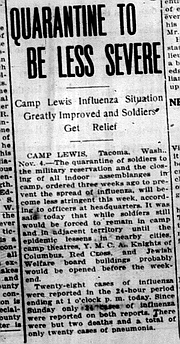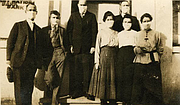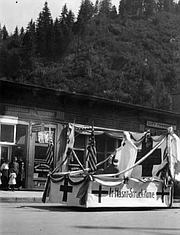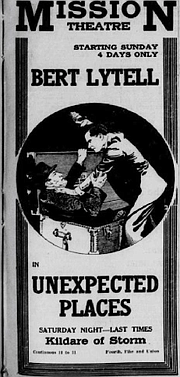1918's influenza epidemic, here: Part 2 - The forgotten scourge
Historical studies of the U.S.’s great influenza epidemic of 1918-1919 often note its relative historical unrememberedness. Even as it was occurring Americans arguably downplayed the epidemic’s harrowing cost in human suffering and deaths. More than a few reasons have been suggested. For one, the influenza epidemic’s worst weeks, in October and November 1918, coincided with the triumphal advances and ultimate victory of the Allied forces in World War I. In the Wallace Press-Times, for example, war coverage dominated October’s and November’s news pages, reducing space available to influenza coverage. The American war effort may even have harbored an implicit warrant that only upbeat, supportive, and positive news should emanate from the American homefront, thus also subtly muting the record of the epidemic’s devastating course. The war’s progress, moreover, was indisputably a public drama playing out on a wide European stage whereas the epidemic’s stateside story was more often one of private tragedy shielded from public view behind the closed doors of afflicted and grieving households.
In Wallace, newspaper coverage through October 1918, conveyed that the epidemic was a problem chiefly elsewhere but not here. A handful of cases were being treated in Wallace, said the paper, but these had come into town from elsewhere. Otherwise, military training camps — with their burgeoning numbers of trainees rushing to fill the war’s massive manpower needs — were a special focus of local news reports. The Wallace Press-Times regularly offered brief accounts on the disease’s ebb and flow at camps across the nation, often painting an ambiguous picture of alternating good and bad influenza news. The paper also kept tabs on the epidemic’s apparent migration across the nation’s big cities, beginning at Boston, then to other major eastern cities, to the Midwest, and finally farther westward. Until relatively late in the game, Wallace and Shoshone County appear to have been regarded as more or less safe havens.
An earlier outbreak of influenza, in the spring of 1918, had manifested itself in a milder form of the disease, which also caused some confusion during the later outbreak in autumn, when influenza took a more dangerous form. Was the autumn outbreak the same milder malady seen earlier in the year or had a newer and more fearful strain of the disease appeared? Some autumnal accounts opted for the less scary option. “Spanish influenza is known throughout the United States now,” suggested a mid-October Wallace Press-Times article, “as the ‘three-day fever,’ and in its less virulent form the patient recovers after the third day.” And although the same article also cautioned that some communities had suffered more serious outbreaks, where deaths had been “numerous,” its overriding tone remained reassuring.
On Thursday, Oct. 10, Wallace and other Shoshone County communities complied with an order from state health authorities to close all public facilities and gathering places, including schools, movie theaters, and churches. Even the courthouse halted its courtroom proceedings on behalf of influenza prevention. Public health advisories also cautioned against both kissing and spitting. In the absence of a demonstrable presence of influenza locally, newspaper coverage turned its attention to the new closures and their notable effects. “With no church services, no Sunday schools and no theaters,” said a Tuesday, Oct. 15 article in the Times, “Wallace residents who had no automobiles were hard pressed to know what to do with themselves.” A hint of wonder graced the paper’s report of the previous Sunday’s sudden quietude:
Probably never before in all its history was Wallace so quiet on a Sunday night. During the fore part of the evening a few strolled down to see if any new war bulletins had arrived, and after satisfying themselves on that score they wandered about for a while and then betook themselves homeward. There was no attraction of any kind to hold them down town, and by 9 o’clock the coming and going of the auto stages, aside from the passing of other autos, was the only sign of life presented, except for the occasional pedestrian who marvelled that he had the streets almost to himself.
An air of urgency didn’t find its way into local newspaper’s epidemic coverage until early November 1918. On Monday, Nov. 4, the paper published news of the imposition of a new and more dramatic preventive measure. As the following day, Nov. 5, all Shoshone County’s residents over the age of five were required to wear masks in all outside-the-home encounters with others. This measure, said the announcement, was necessary because the epidemic had “…reached a serious stage and threatens the health and welfare of the community and drastic measures appear necessary to check the disease…”
It was the first time the newspaper shifted its stance on the epidemic, now sounding a clear alarm. “The full police power of the county,” said the announcement, would be used to enforce the new order’s provisions. Arrangements were being made moreover to provide effective masks to all citizens. Masks could also be crafted by women in their homes, said Mrs. Harry Allen, chairman of the local Red Cross chapter. Detailed instructions on mask making were offered. Masks, added the newspaper’s article, “…should be boiled every night or oftener to sterilize them.” Persons who could not obtain the six layers of the recommended gauze for home mask construction, said the article, could instead use “…four thicknesses of butter cloth or two thicknesses of medium muslin…” Before long, Boy Scouts were detailed to Wallace’s train station to hand out masks to arrivees lacking one.
Two days later, on Wednesday, Nov. 6, came an article titled “REASONS FOR MASK MADE PLAIN NOW.” County Health Officer F.W. Rolfs had reported 411 new cases and 34 deaths from influenza in the week ending Sunday, Nov. 3. Rolfs’ numbers may have stunned some readers. The masks, in short, were no longer a mere precautionary measure. Yet neither the mask’s effectiveness nor the epidemic’s local course were readily apparent. On Saturday, Nov. 9, the newspaper editorialized that health officials needed to do more to keep the public informed of the epidemic’s local course. The county’s citizenry, said the editorial, had embraced the mask-wearing directive without objection. “How well they have complied,” said the editorial, “is best demonstrated by the fact that one cannot walk along the streets of Wallace and see a man, woman or child, or even small baby in a perambulator without a mask.” Now, in turn, suggested the editorial, it fell to local health officials to keep the regularly informed, each night, with news of whether the masks were having their desired preventive effect or not. “The community is entitled to know how the fight against this malady is progressing and it would appreciate the publication of this data by the health officials,” closed the editorial.
Just behind the local paper’s coverage lurked an essential tension between public health expertise, on the one hand, and popular uncertainty, on the other. As the influenza epidemic historian Nancy K. Bristow pointed out in her excellent book, American Pandemic (Oxford University Press, 2012), public health expertise was riding high in the second decade of the twentieth century. As she argued, by 1918 both the supremacy of germ theory (as the chief causal agent for infectious disease) and the contemporaneous rise of the Progressive Movement elevated the status of public health professionals and widened their cultural authority. Although medical science offered no cure for 1918’s influenza, a mood of bold and confident optimism attended the promulgation of public health advice and other measures aimed at thwarting the spread of influenza. The same confident optimism gave rise to a kind of public health hubris, which held that influenza’s actual spread and epidemic proportions must have resulted from the public’s failure to adhere firmly to the good advice public health officials had provided.
Repeated calls for public calm also reflected an aspect of this hubris. Calmness could, to be sure, have good effects for the community. The alternatives, hysteria and panic, might for example lead families to abandon sickened members or even flee into the hinterland. Widespread panic might even dismantle the public institutions — the clinics, doctors, nurses, and volunteers — serving bravely to help the sick. Yet public health calls for calm also harbored the implication that medico-scientific expertise and authority were sound, trustworthy, and effective — that is, if such advice were scrupulously obeyed. It was an implication that likely grew less and less credible as the epidemic progressed through November.
The Wallace Press-Times was in some sense caught in the middle between public health’s authoritative claims and emergent public uncertainty and anxiety. Although the paper repeatedly published the advice and assurances coming from public health authorities, its reports also conveyed that public adherence to these prescribed preventive measures was widespread and strong. For example, the Nov. 9 Times’ editorial I’ve already referenced above reported the following about compliance with the mandatory mask order: “Despite the inconvenience the order has been accepted in the best of faith and no company of soldiers ever more faithfully observed the ‘alert’ to don gas masks than have the citizens of this community in adjusting themselves to the new order of things.” Widespread and rigorous public compliance harbored a sobering implication for the expertise claims of public health authorities. A rigorously compliant citizenry that nevertheless fell victim to the influenza epidemic’s deadly embrace implied of course that public health’s scientific expertise claims had been substantially oversold.
The epidemic took a fearful toll in Shoshone County. Dr. Rolfs’ report of 34 deaths for the week ending Sunday, Nov. 3 makes it possible to suggest a provisional estimate of the epidemic’s overall loss of life countywide. Nine Mile Cemetery, as it happens, holds 12 graves of influenza victims who died that same week. These graves represent 35 percent of the countywide total Rolf reported. If roughly the same ratio obtained over the entire course of the epidemic, then Nine Mile’s total of 68 influenza deaths would translate into an estimated 194 influenza deaths for the county as a whole. According to the decennial census, Shoshone County’s total resident population in 1920 was 14,250. Influenza’s total death toll in the county therefore would have equated to a death rate of 136 per 100,000 population, or about two-and-a-half times the national influenza mortality rate. Of course, the ratio of Nine Mile and countywide deaths may have varied over the epidemic’s full course, thus altering my countywide calculation upward or downward. Still, a heavy price in human life had been paid — made worse by the fact that most of influenza’s victims were felled in the prime of life (see Part 1).
The mask-wearing requirement was lifted on Thursday, Nov. 21. “Wallace citizens were once again able to look each other in the face yesterday after 15 days of muzzling,” reported the next day’s News-Press, “and many were the expressions of relief heard.” Many citizens, the report added, had become so used to wearing the mask that they felt “only half clothed” without it. The general bans on churches, schools, theaters, and other venues were lifted on Sunday, Nov. 23, although children were not allowed to return to movie houses until Friday, the 29th. The Liberty Theater, reported the Wallace Press-Times on the 29th, was showing a film titled “Unexpected Places,” starring Bert Lytell, “the mile-a-minute western star.” “This film has been featured in some of the biggest showhouses in the country,” the Times’ added, “and is famous for its many beautiful outdoor scenes.” A “screaming farce comedy” was also on the program. I wonder if the showing of Bert Lytell’s fast-paced film and a rollicking comedy so soon after the epidemic’s worst period had passed affords us, in retrospect, yet another indirect but telling measure of how readily the scourge could fade from public consciousness and memory.
- • •
Thanks are owed Jennifer Backman, M.D., for assistance she provided in deciphering some of the death certificates reviewed in Part 1 of this article.











